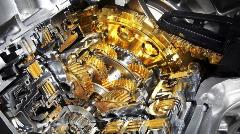Written by
Matthew Croxford

A well-made engine can be a beautiful thing. Harnessed and maintained properly it creates output of incredible value for those who use it.
A key component of any engine is of course the material that keeps all of the distinct interlocking and overlapping parts moving – oil!
Imagine if you will then three distinct types of engines:
One engine contains oil that has become thick, gloopy and heavy. These engines are often large, although not exclusively. They are designed to run machinery that conduct large scale but often simple tasks. The oil in these engines has been there a while and picked up a lot along the way – changing its very nature. The various engine parts still move - but the treacle like consistency of the oil makes the interactions between components slow and sluggish. These engines feel ‘unresponsive’ and though they may get there eventually, its often too late when they do. Sometimes these engines cease up altogether – the oil becoming so thick it makes movement almost impossible – they simply grind to a frustrating halt!
Another type of engine has long lists of impressive features promising outlandish performance. These are expensive ‘flashy’ looking engines. They use premium oil to ensure parts move as fast as possible – or indeed faster! They make a lot of noise and sound impressive, turning heads and making sure they are noticed. Up close it’s a different story. These engines often focus on ‘over tuning’ individual components for the highest performance possible. This ‘over tuning’ of individual components however is done often at the expense of the whole and as such harmony is rarely achieved. Faster moving parts create stress and tension on slower ones – grinding them down and in the end contaminating the oil with the fallout. Things get hot – very hot and in the end usually when performance is most needed – the engine simply burns out – often with highly visible and alarming consequences.
There is a third type of engine, which is neither size or task dependent. They are not flashy on the outside, there are no parts sticking out drawing attention to themselves, no outrageous promises of performance and no amped up sounds to tell you they are there. They may look in some cases unremarkable however what separates them is the efficiency with which they operate. Upon closer inspection their true beauty is revealed. These are engines where the whole is greater than the sum of its parts – they are finely tuned to deliver the utmost effectiveness – veritably purring!

Components move freely and without unnecessary tension. When performance is needed, response times are fast. They run neither hot nor cold and as such outlast others. Ironically it’s not the components that make the difference at least at the start – these engines use components that are available to all – so what is the difference?
The oil – because the oil is special – it’s the good stuff. You can’t buy the good stuff – no one sells it, you can’t acquire it from other engines and put into yours – it doesn’t work that way. You can’t merge your engine with another that has it – they simply aren’t compatible – but many try.
No, you have to care for it – nurture it – refine it, develop it, closely monitor its balance and its health, almost as if it’s a living thing. Its viscosity is truly its secret – mmm viscosity!

Engines with the good oil are ‘symphonies of viscous interdependence’ – now there’s a phrase - things of great beauty that can be relied upon to perform for many years.
Its this 'good oil' that lubricates the system and allows each component to achieve its fullest interdependent potential for the greater good of the whole!
Get working on the good oil today!